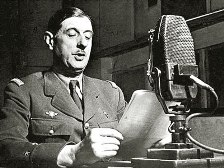During the Second World War, General de Gaulle used the BBC to communicate with the French Resistants. This place is one of the most symbolic places of the Second World War.

BBC Broadcasting House in London, complete in 1932
The BBC (British Broadcasting Company) was founded in 1922 by John Reith and produces programs on British radio and television. In 1927, the BBC becomes the British Broadcasting Corporation, a public company whose goal is to educate, to inform and to entertain. It’s slogan is « Nation Shale Speak Peace unto Nation » which means : « La Nation parle de la paix à la nation».
Wintson Churchill , 1st British Prime Minister , welcomed General de Gaulle who left France for political reasons, and allowed him to launch his call for resistance June 18, 1940 on BBC radio. This speech was not recorded or filmed. General de Gaulle had to return the next day to repeat his call but it did not happen. In contrast, the speech of June 22, 1940 was recorded.

Click on this picture to watch a report on the appeal of June 18th
The BBC was the place of many other speeches to support the French in difficult times and give them hope.

Click on this picture to hear the appeal of the 18th June
Opposing the General Pétain negotiating with Germany for an armistice, this speech invites the French, especially the military, to continue the fight by joining him in London and organizing the French
resistance.
Radio London will be the name given to French-language programs broadcast by the BBC from 6 September 1940 to 22 November 1944.
De Gaulle also sent a message of greetings for Christmas 1941 children to France and he adressed the nation by radio the 6th June, 1944 to support the Allied landing operations in France : « This battle, France will carry it with fury. She will lead the orderly. Thus we have, for fifteen hundred years, each won our victories. This is how we will win this one« .
Early 2013, the BBC staff left the historic building to occupy the new Broadcasting House : a new building of 90000 m2, 7 floors, and 3 basement levels, close fitting to historic quarters.














